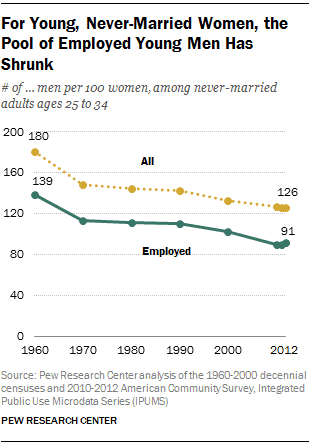Once, women sighed over fairy tale princes or a single man in possession of a large fortune.
Forget the fortune. Now, the desirable bachelor just needs to have a job. Even that, in this economy, is a lot to ask for.
There are fewer employed young men than ever before, the Pew Research Center announced on Wednesday. Just 82% of men in prime working age – 25 to 34 years old – have a job.
The number of – shall we call them eligible? – men has been steadily decreasing over the past 50 years, dropping to just 91 employed men per every 100 women.
Much has changed since 1960, when society was overrun with bachelors and single ladies had their pick of about 139 employed men for every 100 women.
Not only are there fewer employed men, but they also seem to be making less money. That same Pew report found that men ages 25 to 34 have seen their median hourly wages decline by about 20% since 1980.
This will naturally lead to some rough relationships, since both men and women are still hurting six years after the Great Recession.
Women aged 25 to 34 are currently dealing with a higher unemployment rate than men. In August, the unemployment rate for 25 to 34 year old women was 7.2% while for men it was 6.6%.
In that context, it’s no wonder more and more women started looking for a guy with a job and a steady income. The rent, as we know, is too damn high. Food prices are rising. Two-thirds of young Americans graduate with student debt.
If you are thinking that it might be easier altogether to chuck in the towel on all of this, you are not alone. A record number of Americans – 50.2%! – are currently unmarried.
That’s only technically single. Instead of getting married – and intertwining their financial lives through taxes, shared bank accounts and co-dependent credit scores – many Americans are just opting to live together instead.
In 2012, 7.85 million couples were living together without tying the knot. That’s compared to just 6.7 million couples in 2009.
So, men, if your date expects you to pay for that first date in the near future, it might just be that she wants to know that one of you can afford it.


Comments (…)
Sign in or create your Guardian account to join the discussion